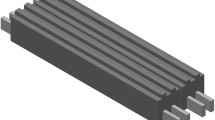Abstract
Energy saving technology based on steady flow and heat preservation (ESTSH) has been developed by Zhengzhou Non-ferrous Metals Research Institute Co. Ltd of CHALCO. Starting with research from 2013, this technology aims at low D.C. power consumption for aluminum reduction. Based on numerical simulation modeling, integrated design with aluminum cathode steady flow, low voltage drop cathode assembly technology, redesign the isotherm distribution of the lower part of the cell body and operation acknowledge, the new design criterion is established for ESTSH. About more than 400 cells from 200 to 500 kA based on ESTSH have been rebuild in several smelters in China. The ESTSH cells produce steadily with cell voltage of 3.75–3.85 V, current efficiency of 92.0–94.0%, and D.C. power consumption of 12,200–12,500 kWh/t-Al. This paper presents the characteristics and performance of ESTSH cells.
Access this chapter
Tax calculation will be finalised at checkout
Purchases are for personal use only
Similar content being viewed by others
References
Gu SQ, Liu FQ, Yang HJ, et al. (2010) A cathode structure of aluminum reduction cells. China Patent 200920109237.8, 17 March 2010.
Liu FQ, Gu SQ, Wang JM, et al. (2011) Application of New Structure Reduction Cell Technology in Chalco’s Smelters. Light Metals: 509–512.
Feng NX. (2007) A aluminum reduction cell with abnormal cathode carbon block. China Patent 200710010523.4, 17 October 2007.
Yang XD, Zhou DF, Liu YF, et al. (2011) A structure of significantly decreasing aluminum liquid horizontal current in the aluminum reduction cell. China Patent 201020566373.2, 15 June 2011.
Zhou DF, Yang XD, Liu Wei, (2011) Development and application on the metal flow pattern (retarding flow) optimization energy-saving technology. Light Metals: 27–33.
Li WX, Zhang YF, Chai DP, et al. (2014) Simulation and optimization of cathode current distribution to reduce the horizontal current in the aluminum liquid. Light Metals: 495–501.
Shi ZR, Chai DP, Huang HB, et al. (2016) Technology research on decreasing the aluminum surface waves and reducing the cathode voltage drop in aluminum electrolysis cell. Light Metals: 613–616.
Author information
Authors and Affiliations
Corresponding author
Editor information
Editors and Affiliations
Rights and permissions
Copyright information
© 2018 The Minerals, Metals & Materials Society
About this paper
Cite this paper
Chai, D. et al. (2018). The Successful Implementation of Energy Saving Technology Based on Steady Flow and Heat Preservation. In: Martin, O. (eds) Light Metals 2018. TMS 2018. The Minerals, Metals & Materials Series. Springer, Cham. https://doi.org/10.1007/978-3-319-72284-9_77
Download citation
DOI: https://doi.org/10.1007/978-3-319-72284-9_77
Published:
Publisher Name: Springer, Cham
Print ISBN: 978-3-319-72283-2
Online ISBN: 978-3-319-72284-9
eBook Packages: Chemistry and Materials ScienceChemistry and Material Science (R0)




